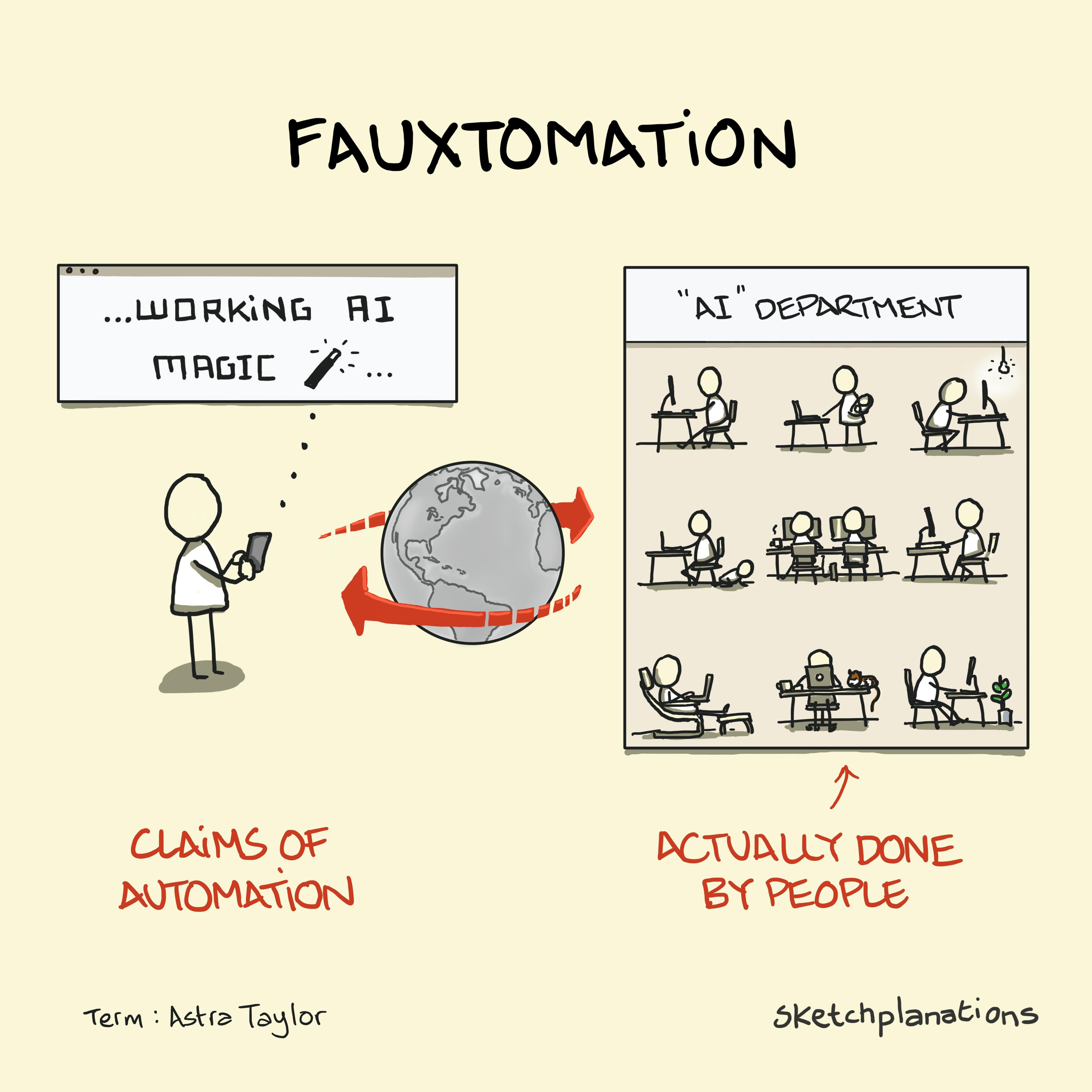Fauxtomation

- Prints
- Copied!
👇 Get new sketches each week
Writer and filmmaker Astra Taylor explains fauxtomation as "the process that renders invisible human labour to maintain the illusion that machines and systems are smarter than they are." (Faux means false or fake in French).
Taylor gives an example of standing in line to collect food and the person in front of her expressing amazement at how the app knew his order was done 20 minutes early. The server replies, "I sent you a message."
With the rise in incredible abilities driven by AI chatbots and tools, it's tempting to believe that AI can run anything. But, in many situations, claims of AI magic and sophisticated automation disguise work done by people—often outsourced and poorly paid.
An example of fauxtomation is content moderators, whose job is to review and filter objectionable content from the web when the claim is that sophisticated algorithms and AI are doing the work. Other examples are tagging or searching images, transcribing audio, responding to customer queries, making decisions, or, ironically, training machine learning models. In another twist, ordering on the app or touchscreen at McDonalds or the self-checkout at a supermarket, you, as a customer, become the labour of a server or waiter.
Some have argued that automation polarises work into vast quantities of small, menial tasks feeding the machines on one end and sophisticated, high-skilled work in designing and maintaining the machines at the other.
Amazon has long offered its Mechanical Turk service , which crowdsources assignments with a distributed workforce—they called it artificial, artificial intelligence. The original Mechanical Turk was a hoax from the 1700s where a concealed human chess player fooled onlookers into believing a machine was playing.
As a design and UX professional, I've used the Wizard of Oz prototype technique. Named after the infamous wizard secretly controlling impressive machines from behind a curtain, the idea is to give the appearance of a working software prototype by discreetly controlling what people see based on their actions.
AI promises instant automation, but that's rarely the case. As you work to automate and remove inefficiencies, it's natural that systems should be supported by people. Human-augmented work may be a more appropriate term. In many domains, especially where safety is at stake, such as in self-driving cars, reviewing legal documents, or automated background checks, oversight by people may remain critical.
Alongside the AI revolution, a quiet revolution nearly as significant for our everyday experience is the tying together of different tools for automation. Tools like Zapier, Google Sheets, Notion, and the growth of APIs allow us to automate workflows across systems, saving massive amounts of time and effort.
While the vision of machines reducing our labour persists, history shows that they often drive increased productivity instead of reducing work. This echoes Jevon's paradox, where fuel efficiency gains usually result in increased fuel usage rather than less.
I saw an excellent talk by machine learning and AI expert James Smith , in which, before you try machine learning ("I hear you have Magic Pixie dust. Can I have some?"), he would ask, "Have you tried 50 IF statements?" These programmed rules will be more maintainable, less complex, and result in responses that are easy to understand.
I learned about fauxtomation from Tom Humberstone 's remarkable visual essay What Luddites Can Teach us About Resisting an Automated Future in the MIT Technology Review. Fauxtomation is similar in concept to Potemkin AI, a term from researcher Jathan Sadowski .
You can read Astra Taylor's article, The Automation Charade , or watch her discuss fauxtomation at the AI Now 2018 symposium .
Sketchplanations continues to be done by me, by hand. If you'd like to support me , I'm improving my Patreon, which makes such a difference in helping creators like me keep creating. Thank you.
Here's a fauxtomation sketch by ChatGPT in case you're interested =)
Also see:
As well as fauxtomation prints , you can get AI department prints

